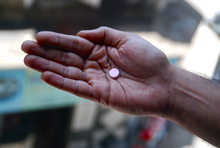Whenever Dylan Mohan Gray, the director of Fire in the Blood, is asked what the film is about, these are the words he uses: “the crime of the century.” This impressive and highly-engrossing film tells the story of big pharma, patent law, and how profit is placed before human life.
The film tells the story of the struggle to enable access to medicine for AIDS victims in Sub-Saharan Africa, who were still dying in their millions for many years after antiretroviral drugs had transformed HIV into a treatable condition in the West. 10 million or more people died preventable deaths as a direct result of Western pharmaceutical companies and governments blocking access to affordable, available generic medicine.
The documentary puts a human face on the issue, with many memorable contributions both from well-known names and from ordinary Africans affected by the virus. HIV-positive Human rights activist Zackie Achmat refused to take antiretroviral treatment, despite rapidly failing health, until the South African government publicly funded the medicines for all. Yusuf Hamied, the chairman of Indian generic drug company CIPLA, turned the tide when he offered to supply the AIDS drugs for less than $1 a day to developing countries, and to share the technological knowledge necessary for production. Lisa Kalolo, a South-African child faced a bleak future, but thanks to ART she is now attending school and living a normal life.
However, although the AIDS situation appears to be solved, we are warned that those currently taking “first-line” ARVs will, in the future, have to change to more complex ARVs which are not, and are unlikely to be, available in generic form. Director Dylan Mohan Gray also points out that AIDS in the developing world is only part of the scandal of big pharma and patent regulation: almost 50% of Americans are unable to afford their prescriptions, and approximately 33% of deaths worldwide each year are caused by treatable and preventable diseases. This situation looks set to disimprove significantly as American and European trade measures continue to cut off the supply of affordable drugs from India.
This is an important film about a significant matter which is of relevance to anyone. The implications for the world from this issue are wide ranging, and it almost feels as if Fire in the Blood should just be the first of a series of documentaries that explores the future of access to affordable medicine. This affects us all. Please watch this film.
For more information, or to find a screening near you, visit www.fireintheblood.com.
Mary Tynan

